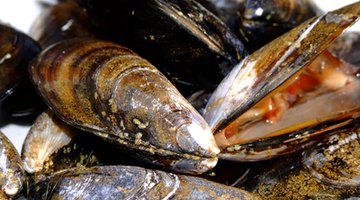How to Grow Freshwater Mussels
Freshwater mussels are categorized as a mollusk, like clams and oysters. They live in aquatic environments where water runs freely and has a high oxygen content. This type of environment provides the organic particles and microorganisms that freshwater mussels need to survive.

Things You Will Need
- Shallow specimen tank
- Larger fish tank for host fish
- Aeration equipment for tank
- Salt
- Microscope
- Net
- Bedding for bottom of tank
Tip
Inspect the host fish for two weeks after introducing the glochidia to check for juvenile mussels.
Warning
Make sure the glochidia do not over-infest the host fish. This condition can lead to the fishes decline or death, according to the West Virginia Division of Natural Resources.
Freshwater mussels are considered a highly endangered species in most of the United States.
The zebra mussel and quagga mussel are considered invasive species and have played a significant role in the decline of native North American freshwater mussel species.
Freshwater mussel embryos are called “glochidia,” which attach to the tissues of certain types of fish until they mature and fall to the floor of the river. Freshwater mussels are an important food source for mammals like the muskrat, otter and raccoon, but they are also a valuable filtering mechanism for the waters that flow through our communities.
-
Set up a specimen container where you can observe and grow the mussels. This should be a shallow container, free of contaminants.
-
Get freshwater mussel embryos, called glochidia, from female mussels. These glochidia are the fertilized eggs that reside in the female mussel gills. Your local university aquatic studies department may be able to provide these for you. Your state division of Fish and Wildlife Service is another source.
-
Place a few crystals of salt alongside each of the glochidia. Salt is used to simulate the chloride found in fish blood that the glochidia require for development.
-
Observe the glochidia to see which close around the salt particles. The viable glochidia will close rapidly. Others will close more slowly. Some of the specimens may not close around them at all; these are not considered viable. Remove these from your specimen tank.
-
Place the viable glochidia in an aerated tank with fish species that are known to host the glochidia in your locality. These fish will be the host for the juvenile mussels.
-
Remove the fish to another tank and inspect for the development of juvenile mussels.
-
Collect juvenile mussels when they fall to the bottom at maturity and provide suitable organic particles and alga to sustain them. Consult with your local Fish and Wildlife Service or university for suitable nutrition for your locality.
-
Provide suitable bedding at the bottom of tank for mussels to attach.
-
Continue aeration for movement of nutrition and washing away of waste products.
-
Never introduce freshwater mussels that you've cultivated to natural waterways, as the ecosystem of that waterway could be seriously compromised.
References
Photo Credits
- mussels image by citylights from Fotolia.com
- mussels image by citylights from Fotolia.com
More Articles



